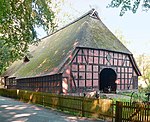Visselhövede

Visselhövede (German pronunciation: [fɪsəlˈhøːvədə] ) is a town in the district of Rotenburg in Lower Saxony, Germany. Nearby towns include the district capital Rotenburg, Walsrode and Verden. Larger cities within a 100 km radius are Bremen, Hanover and Hamburg. Visselhövede belonged to the Prince-Bishopric of Verden, established in 1180. In 1648 the Prince-Bishopric was transformed into the Principality of Verden, which was first ruled in personal union by the Swedish Crown - interrupted by a Danish occupation (1712–1715) - and from 1715 on by the Hanoverian Crown. The Kingdom of Hanover incorporated the Principality in a real union and the Princely territory, including Visselhövede, became part of the new Stade Region, established in 1823.
Excerpt from the Wikipedia article Visselhövede (License: CC BY-SA 3.0, Authors, Images).Visselhövede
L 161,
Geographical coordinates (GPS) Address Nearby Places Show on map
Geographical coordinates (GPS)
| Latitude | Longitude |
|---|---|
| N 52.966666666667 ° | E 9.5833333333333 ° |
Address
L 161
27374
Lower Saxony, Germany
Open on Google Maps









